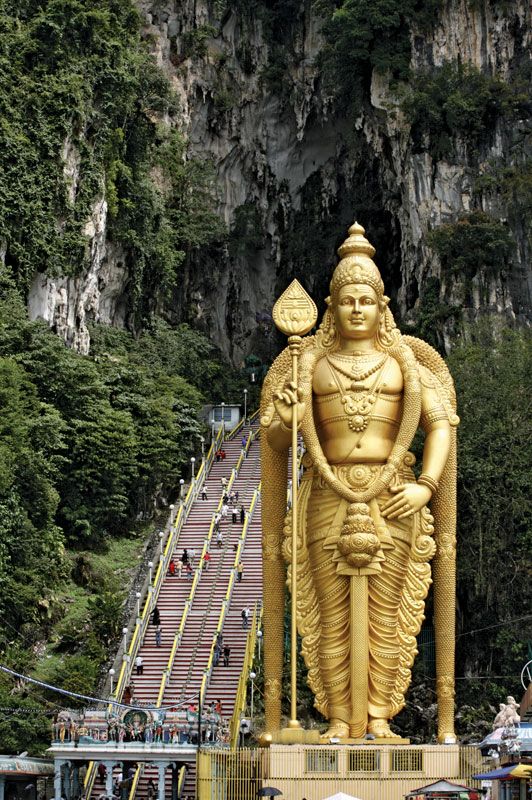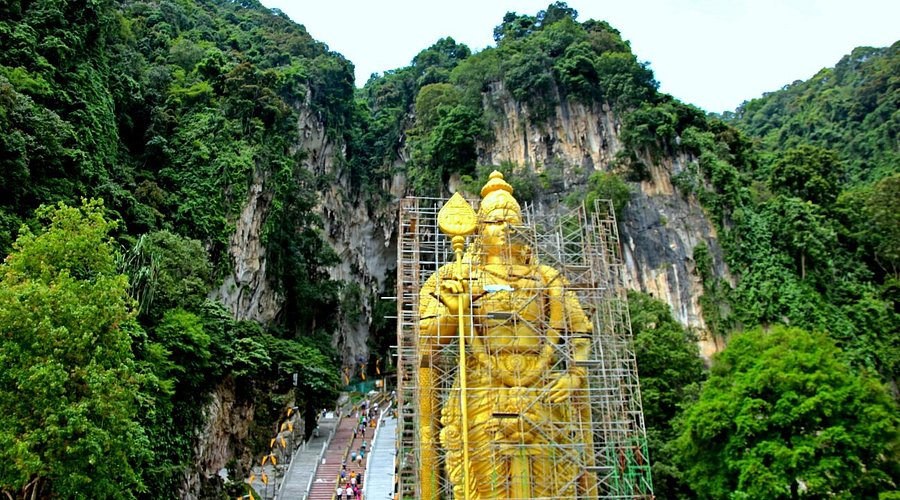Discover the Majestic Batu Caves in Selangor, Malaysia: A Natural and Cultural Wonder
Exploring the Batu Caves in Selangor, Malaysia, offers a unique blend of natural beauty, historical significance, and spiritual heritage. This iconic site, renowned for its towering limestone formations and vibrant Hindu temples, attracts millions of visitors annually who seek to experience its breathtaking scenery and cultural richness. The caves are not only a marvel of geological formation but also a vital religious center, hosting important festivals and rituals that reflect the deep-rooted traditions of the local community. Whether you’re interested in exploring the stunning natural caves, admiring intricate religious sculptures, or participating in vibrant celebrations, Batu Caves in Selangor, Malaysia, provides an unforgettable experience that combines nature, history, and spirituality in one extraordinary destination.
For more detailed information about visiting and exploring this remarkable site, visit Batu Caves-Iran Charter. Discover the beauty and cultural significance of Batu Caves in Selangor, Malaysia, and plan your trip to this must-see attraction today.

Discover the Rich History and Evolution of Batu Caves in Malaysia
Batu Caves in Malaysia boast a history spanning over 400 million years, making them one of the most historically significant natural sites in Southeast Asia. Originally used as sacred sites by indigenous communities, these caves have evolved into prominent religious and cultural landmarks. The development of Hindu temples within the caves began in the early 20th century, transforming Batu Caves into a vibrant hub of spiritual activity and cultural heritage. Over centuries, the site has witnessed numerous religious festivals, especially during the annual Thaipusam celebration, attracting millions of devotees and tourists alike. The caves have also played a pivotal role in shaping the cultural identity of the local community, symbolizing resilience and spiritual devotion. Today, Batu Caves stand as a testament to Malaysia’s diverse heritage, blending natural wonder with profound religious significance. Preservation efforts continue to protect this historic site, ensuring that its legacy endures for future generations. Visitors can explore the ancient formations and learn about the cultural stories that have been passed down through generations, making Batu Caves a must-visit destination for history enthusiasts. The site’s evolution from primitive shelters to a global religious icon highlights its importance in the region’s cultural landscape. As a UNESCO-recognized heritage site, Batu Caves exemplify the harmonious coexistence of natural beauty and spiritual tradition in Malaysia.
The Geology and Formation of Batu Caves: Natural Wonders in Limestone
Batu Caves are a remarkable example of karst limestone formations that have developed over millions of years. The caves were formed through natural processes involving the dissolution of limestone by underground water, creating vast underground chambers and towering stalactites and stalagmites. These geological processes have resulted in stunning natural structures that captivate visitors, with some formations reaching heights of over 100 meters. The limestone’s unique composition has also contributed to the caves’ durability and distinctive appearance, making them a prime example of natural erosion and sedimentation. Inside the caves, visitors can observe various mineral deposits and geological features that tell the story of Earth’s natural history. The complex network of tunnels and chambers showcases the power of natural forces shaping the landscape over eons. Researchers study these formations to better understand the region’s geological past and the processes that continue to shape the landscape today. The caves’ natural architecture provides a breathtaking backdrop for cultural and religious activities, blending science and spirituality seamlessly. The limestone formations not only serve as a natural monument but also as a scientific resource for studying Earth’s geological evolution. Protecting these geological features is crucial for maintaining the ecological and scientific integrity of Batu Caves for future generations.
Unique Biodiversity Within Batu Caves: Endemic Species and Ecological Significance
Batu Caves are home to a diverse array of flora and fauna, many of which are endemic to the region. The caves provide a sanctuary for various species of bats, insects, and small mammals, playing a vital role in maintaining the ecological balance. Notably, the caves host a large population of bats that contribute to the local ecosystem through their guano, which enriches the soil and supports plant growth. Several rare and endangered species of insects and arachnids thrive in the dark, humid environments of the caves, making it an important site for biological research. The surrounding limestone hills are also rich in native plant species, some of which are medicinal or rare. Conservation efforts focus on protecting this fragile biodiversity from the impacts of tourism and urban development. Educating visitors about the ecological importance of Batu Caves helps foster responsible tourism practices. The presence of unique species highlights the caves’ role as a natural habitat and underscores the need for sustainable management. Preserving this biodiversity ensures that the ecological functions of Batu Caves remain intact, supporting both scientific study and environmental health. The ecological richness of Batu Caves makes it not only a cultural site but also a vital natural reserve for endemic species.
Architectural and Religious Significance of Temples in Batu Caves
The temples within Batu Caves exemplify traditional Hindu architecture, featuring intricate carvings, vibrant statues, and elaborate sculptures. The most iconic structure is the massive golden statue of Lord Murugan, standing at 42.7 meters tall, which serves as a spiritual beacon for devotees and visitors. The temples are decorated with colorful murals and detailed stone carvings that depict stories from Hindu mythology, reflecting centuries of artistic craftsmanship. These religious structures are active places of worship, hosting daily rituals, festivals, and special ceremonies that draw pilgrims from around the world. The design of the temples harmonizes with the natural limestone caves, creating a sacred atmosphere that enhances spiritual experience. During major festivals like Thaipusam, the temples become vibrant centers of devotion, with processions, offerings, and traditional performances. The architecture not only serves religious purposes but also preserves traditional art forms and cultural heritage. Visitors can explore the different levels of the caves, each containing shrines dedicated to various deities, illustrating the depth of religious symbolism. The temples’ integration into the natural landscape exemplifies a harmonious blend of spirituality and nature. Maintaining the integrity of these structures is essential to preserve their cultural and religious significance for future generations.
Celebrating Thaipusam at Batu Caves: Rituals, Traditions, and Cultural Impact
The Thaipusam festival at Batu Caves is one of the most spectacular Hindu celebrations worldwide, attracting millions of devotees annually. Participants undertake a pilgrimage to the caves, often carrying kavadis—ornate frameworks pierced with hooks and skewers—as acts of devotion and penance. The ritual involves elaborate ceremonies, including prayers, offerings, and processions that symbolize spiritual cleansing and devotion to Lord Murugan. Devotees often engage in acts of physical endurance, such as body piercing, to demonstrate faith and seek blessings. The vibrant procession, accompanied by traditional music and dance, transforms Batu Caves into a lively cultural hub during the festival period. The event also has a significant cultural impact, fostering community bonding and cultural identity among Malaysians and visitors from abroad. The festival’s scale and spiritual intensity make it a unique experience, blending religious fervor with cultural expression. Visitors are encouraged to observe respectfully and learn about the deep spiritual meaning behind the rituals. The celebration of Thaipusam at Batu Caves exemplifies the enduring importance of faith and tradition in Malaysian society. Ensuring the safety and preservation of this event is vital for maintaining its cultural legacy and attracting future generations of devotees and tourists alike.
Additional Attractions and Natural Features Around Batu Caves
Beyond the main caves and temples, Batu Caves offers a variety of natural and recreational attractions. The surrounding limestone hills feature hiking trails and scenic viewpoints that provide panoramic views of Kuala Lumpur and the surrounding landscape. Adventure enthusiasts can explore the numerous trekking paths that wind through lush greenery and rocky outcrops, making it an ideal spot for outdoor activities. Nearby, visitors can visit the Batu Caves Eco Park, which offers educational exhibits about local flora and fauna, as well as picnic areas for families. The area also hosts waterfalls and natural pools, perfect for relaxation after a hike. For those interested in photography, the dramatic limestone formations and vibrant temple decorations create stunning visual opportunities. Local vendors and markets around Batu Caves sell traditional snacks, souvenirs, and handicrafts, enriching the cultural experience. The region’s natural beauty complements the spiritual ambiance of the caves, making it a comprehensive destination for nature lovers and cultural explorers. Visitors are advised to wear comfortable shoes and carry essentials to fully enjoy the outdoor attractions. These additional features enhance the overall experience, making Batu Caves a multifaceted site that combines natural wonder, adventure, and cultural richness.
Environmental Challenges and Conservation Strategies for Batu Caves
As a popular tourist and religious site, Batu Caves faces environmental challenges such as pollution, habitat disturbance, and over-tourism. Increased foot traffic can lead to littering, erosion of natural pathways, and damage to delicate limestone formations. Urban development around the area also poses risks to the ecological balance and natural landscape. To address these issues, conservation programs focus on waste management, visitor education, and habitat preservation. Signage and guided tours promote responsible tourism, encouraging visitors to respect the environment. Local authorities collaborate with environmental organizations to implement measures that control access to sensitive areas and prevent degradation. Restoration projects aim to repair damaged structures and stabilize natural features, ensuring the longevity of the site. Community involvement and awareness campaigns play a crucial role in fostering sustainable practices among visitors and locals. Protecting the biodiversity and geological features of Batu Caves is essential for maintaining its status as a natural and cultural heritage site. Ongoing monitoring and adaptive management strategies are necessary to balance tourism growth with environmental preservation, securing Batu Caves’ future as a treasured landmark.
Practical Tips for Visiting Batu Caves: Best Times, Accessibility, and Visitor Guidelines
The optimal time to visit Batu Caves is during the cooler months from November to February, when the weather is more comfortable for exploring. Early mornings or late afternoons are ideal to avoid crowds and enjoy the tranquility of the site. Accessibility is convenient, with well-maintained pathways and a staircase of 272 steps leading up to the main caves, suitable for most visitors. For those with mobility challenges, alternative routes and assistance are available, ensuring inclusive access. Visitors should wear comfortable footwear, carry water, and bring sun protection, especially during peak hours. Photography is permitted, but flash photography inside temples should be avoided out of respect for worshippers. It’s advisable to dress modestly, covering shoulders and knees, to adhere to cultural norms. Guided tours are available for a deeper understanding of the site’s history and significance. Respect for religious practices and environmental guidelines helps preserve the sanctity and natural beauty of Batu Caves. Planning ahead ensures a safe, enjoyable, and meaningful visit to this iconic Malaysian landmark.
The Cultural and Social Impact of Batu Caves on Malaysian Society
Batu Caves holds a central place in Malaysian cultural identity, symbolizing religious diversity and spiritual harmony. As a major Hindu pilgrimage site, it fosters community cohesion and cultural pride among Indian Malaysians and the broader society. The site’s festivals, especially Thaipusam, serve as vibrant expressions of faith, tradition, and cultural heritage, strengthening social bonds. Beyond its religious significance, Batu Caves also contributes to the local economy through tourism, supporting businesses and creating employment opportunities. The site acts as a cultural bridge, promoting understanding and respect among different ethnic groups in Malaysia. Educational programs and cultural events held at Batu Caves help preserve traditional arts, crafts, and rituals, passing them on to future generations. The site’s iconic status has also made it a symbol of multicultural Malaysia on the global stage. Efforts to maintain its cultural integrity involve collaboration between religious leaders, government agencies, and local communities. Overall, Batu Caves exemplifies how cultural heritage sites can influence social cohesion, national identity, and intercultural dialogue in Malaysia.

Frequently Asked Questions about Batu Caves in Malaysia
- What is the historical significance of Batu Caves?
- Batu Caves has a history spanning over 400 million years, originally serving as sacred sites for indigenous communities. Over time, it evolved into a major religious and cultural landmark, especially for Hindu devotees, hosting festivals like Thaipusam and becoming a symbol of spiritual devotion and resilience in Malaysia.
- How were Batu Caves formed geologically?
- The caves are natural limestone formations created through millions of years of geological processes involving the dissolution of limestone by underground water. This resulted in vast underground chambers, stalactites, stalagmites, and impressive natural structures that continue to shape the landscape.
- What kind of biodiversity can be found in Batu Caves?
- Batu Caves is home to diverse species, including endemic bats, insects, and small mammals. The caves support a rich ecosystem, with bats contributing to soil fertility through guano, and various rare insects thriving in the humid, dark environments, making it an important site for ecological research.
- What are the main architectural features of the temples inside Batu Caves?
- The temples showcase traditional Hindu architecture, featuring intricate carvings, colorful statues, and elaborate sculptures. The most prominent is the golden Lord Murugan statue, standing 42.7 meters tall, which is a focal point for worship and festivals.
- What is the significance of Thaipusam festival at Batu Caves?
- Thaipusam is one of the largest Hindu festivals globally, attracting millions. Devotees undertake pilgrimages, often carrying kavadis pierced with hooks and skewers, as acts of devotion. The festival involves rituals, processions, and cultural performances, symbolizing spiritual cleansing and faith.
- Are there other attractions around Batu Caves?
- Yes, the surrounding limestone hills offer hiking trails, scenic viewpoints, waterfalls, and natural pools. The Batu Caves Eco Park provides educational exhibits and picnic areas, making it a great spot for outdoor activities and nature exploration.
- What environmental challenges does Batu Caves face?
- High tourist traffic leads to pollution, erosion, and habitat disturbance. Urban development also threatens the natural landscape. Conservation efforts include waste management, habitat preservation, visitor education, and restoration projects to protect this heritage site.
- How can visitors best prepare for a trip to Batu Caves?
- Visit during cooler months, wear comfortable shoes, carry water, and dress modestly. Use guided tours for deeper insights, and respect religious practices. Early mornings or late afternoons are ideal to avoid crowds and enjoy a peaceful experience.
- What role does Batu Caves play in Malaysian society?
- Batu Caves is a symbol of religious diversity and cultural identity, fostering community bonds through festivals like Thaipusam. It also boosts the local economy via tourism and promotes multicultural understanding and respect among Malaysians.
- Is Batu Caves a UNESCO World Heritage Site?
- While Batu Caves is recognized as a significant cultural and natural landmark, it is not officially listed as a UNESCO World Heritage Site. However, its cultural, geological, and ecological importance makes it a protected and celebrated site in Malaysia.
- Are there any safety tips for visiting Batu Caves?
- Yes, visitors should wear suitable footwear, stay hydrated, and be cautious on the steps. Respect religious rituals, avoid flash photography inside temples, and follow guidelines to ensure safety and preservation of the site.
- Can I visit Batu Caves with children or elderly?
- Yes, but with caution. The staircase has 272 steps, which might be challenging for some. Assistance and alternative routes are available for those with mobility issues. It’s advisable to plan accordingly for a comfortable visit.
- What are the best times to visit Batu Caves?
- The best time is during the cooler months from November to February. Early mornings or late afternoons are recommended to avoid crowds and enjoy a more peaceful experience.
- How does Batu Caves contribute to Malaysian culture?
- It serves as a major religious site, a symbol of multicultural harmony, and a hub for festivals and cultural events. The site promotes understanding among different ethnic groups and preserves traditional arts and rituals.
- Are there any restrictions or guidelines for visitors?
- Visitors should dress modestly, avoid disturbing worshippers, and follow environmental guidelines. Photography is allowed outside but should be respectful inside temples. Littering and disrespectful behavior are prohibited to maintain sanctity and cleanliness.

























